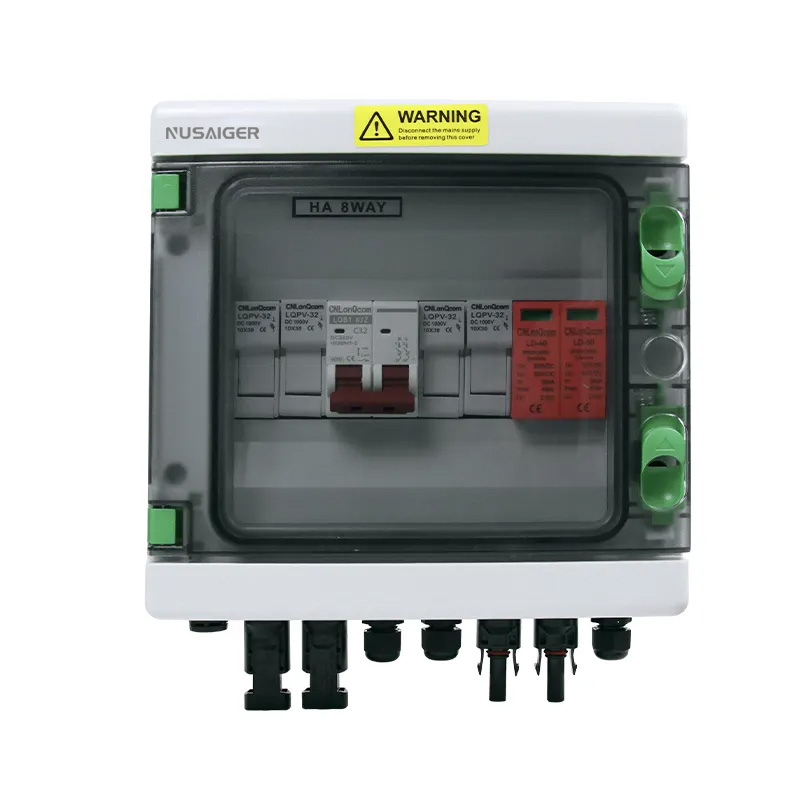The Future of PV Combiner Boxes: Smart Monitoring and Integration Trends
As solar power grows into a mainstream source of electricity worldwide, every component in a photovoltaic (PV) system is evolving toward
higher efficiency, greater intelligence, and seamless integration. The PV combiner box—a device once viewed as a simple
junction box for merging multiple solar strings—is now at the center of technological transformation. Future-ready combiner boxes are
designed not only to combine power but also to monitor, protect, communicate, and optimize solar system performance.
1. Why the Future of PV Combiner Boxes Matters
Traditional PV combiner boxes provided only the basic functions: string fusing, surge protection, and a central point of connection.
However, with the growth of large-scale solar plants, energy digitalization, and grid modernization, next-generation combiner boxes must support:
- Smart monitoring of current, voltage, and temperature
- Remote diagnostics and predictive maintenance
- Grid compliance and communication standards
- Integration with SCADA, IoT, and AI platforms
- Cybersecurity for data-driven solar assets
2. Evolution of PV Combiner Boxes
The progression of PV combiner boxes can be divided into three main generations:
- First Generation: Basic combiner boxes with fuses, breakers, and surge protectors.
- Second Generation: Boxes with integrated DC disconnect switches and improved safety features.
- Third Generation (Present): Smart combiner boxes with monitoring sensors, communication modules, and IoT connectivity.
The next generation aims to go beyond monitoring—enabling predictive maintenance, AI-driven decision-making, and seamless grid integration.
3. Smart Monitoring Capabilities
Modern PV plants require real-time visibility into system performance. Advanced PV combiner boxes integrate sensors and electronics for:
- String-level current monitoring – Detects underperforming or disconnected strings.
- Voltage and insulation resistance monitoring – Prevents ground faults and short circuits.
- Thermal sensors – Identifies hotspots before they cause failures.
- Energy metering – Tracks performance for O&M (operations and maintenance).
- Data logging – Provides historical performance trends.
4. IoT and Cloud Integration
Internet of Things (IoT) technology transforms PV combiner boxes from passive equipment into connected intelligence hubs. Benefits include:
- Cloud-based dashboards accessible from anywhere
- Remote troubleshooting and fault identification
- Integration with smart grids for demand-response participation
- Automated alerts via SMS, email, or app notifications
This connectivity reduces maintenance costs by enabling condition-based servicing rather than scheduled, labor-intensive inspections.
5. Artificial Intelligence and Predictive Maintenance
Future PV combiner boxes will not only collect data but also interpret it using AI algorithms. Predictive analytics will allow:
- Detection of performance anomalies before failures occur
- Optimization of fuse replacement cycles
- Prediction of SPD degradation due to surge exposure
- Dynamic adjustment of operating parameters to extend lifespan
By combining machine learning with real-time monitoring, operators can reduce downtime and maximize solar plant availability.
6. Cybersecurity in Smart PV Combiner Boxes
With greater connectivity comes the risk of cyberattacks. Future-ready PV combiner boxes must include:
- Encrypted communication protocols (TLS, VPN, etc.)
- Secure firmware updates with authentication
- Access control for remote monitoring systems
- Event logging to detect unauthorized access attempts
As solar power plants are increasingly considered critical infrastructure, ensuring cybersecurity at the combiner box level will be essential.
7. Grid-Integration and Compliance Trends
Grid codes worldwide are evolving to require more intelligent behavior from PV systems. Future combiner boxes will support:
- Automatic grid disconnection during faults
- Voltage ride-through and frequency support functions
- Data sharing with grid operators for balancing supply and demand
Compliance with standards such as IEC 61850, IEEE 1547, and Modbus communication protocols will become mandatory.
8. Integration with Energy Storage Systems
The growing role of battery storage in solar installations will influence combiner box design. Future boxes may:
- Include bidirectional DC protection for battery integration
- Monitor charge/discharge rates alongside PV production
- Coordinate energy flows between solar, storage, and grid
This creates a single intelligent hub managing both generation and storage.
9. Digital Twin Technology
Digital twin models of PV systems will allow real-time simulation of combiner box performance. This provides:
- Accurate failure prediction
- Virtual testing of system upgrades
- Enhanced asset management across multiple solar plants
As digital twins become mainstream, combiner boxes will be key data nodes feeding these models.
10. Case Study: Smart PV Combiner Deployment
A 100MW solar farm in India deployed smart combiner boxes with IoT sensors and Modbus communication. The system detected string imbalances
early, reducing downtime by 40% and increasing annual energy yield by 3%. Predictive maintenance cut O&M costs by 25%, demonstrating the
tangible benefits of intelligent combiner solutions.
11. Challenges in Adopting Smart Combiner Boxes
- Higher initial cost compared to traditional combiner boxes
- Need for skilled technicians to manage smart features
- Standardization gaps in communication protocols
- Cybersecurity risks requiring robust defenses
However, as prices fall and technology matures, smart combiner boxes will become the new standard.
12. Future Outlook: Toward Autonomous Solar Plants
The long-term vision for PV combiner boxes is full autonomy, where:
- AI-driven algorithms self-adjust system operation
- Combiner boxes communicate directly with inverters, storage, and grid
- Faults are self-diagnosed and auto-corrected where possible
- Human intervention is minimized, reducing O&M costs dramatically
By 2030, PV combiner boxes are expected to evolve into multi-functional digital hubs rather than simple electrical enclosures.
Conclusion
The future of PV combiner boxes lies in smart monitoring, IoT integration, AI-driven predictive maintenance,
and enhanced grid interaction. While challenges remain, these advancements promise to revolutionize solar asset management,
reduce downtime, and maximize energy yield. As the solar industry embraces digitalization, the PV combiner box will no longer be
just a junction point—it will be the brain of the solar field.



